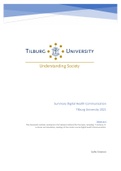Summary Digital Health Communication
Tilburg University 2021
Abstract
This document contains summaries of all relevant material for the exam, including: T-Lectures, D-
Lectures and mandatory readings of the master course Digital Health Communication.
Sofie Emmen
,Summary Digital Health Communication – Tilburg University 2021
Summary Digital Health Communication – Tilburg University 2021 ....................................................... 0
Lecture 1: Introduction to digital health communication ....................................................................... 2
T1 Literature ............................................................................................................................................ 3
A theory-based online health behavior intervention for new university students – Epton et al., 2013 4
A theory-based online health behaviour intervention for new university students (U@ Uni:
LifeGuide)– Camron et al., 2015 .............................................................................................................. 7
T1 Lecture – Persuasive Technology Part 1 .......................................................................................... 10
T2 Literature .......................................................................................................................................... 14
Using feedback through digital technology to disrupt and change habitual behavior: A critical review
of current literature – Hermsen et al. (2016) ........................................................................................ 15
Effects of eating with an augmented fork with vibrotactile feedback on eating rate and body weight –
Hermsen et al. (2019) ............................................................................................................................ 17
T2 Lecture: Persuasive technology part 2 ............................................................................................. 19
T3 Literature .......................................................................................................................................... 25
A cross-cultural comparison of the processes underlying the associations between sharing of and
exposure to alcohol references an drinking intentions – Geusens et al. (2020)................................... 26
A comparison of physical activity mobile apps with and without existing web-based social networking
platforms – Petersen et al. (2019) ......................................................................................................... 28
T3 Lecture: Social aspects of digital health communication ................................................................. 29
T4 Literature .......................................................................................................................................... 36
Theoretical perspectives of adherence to web-based interventions – Ryan et al. (2018) ................... 37
From self-reliers to expert-dependents: identifying classes based on health-related need for
autonomy and need for external control among mobile users – Smit & Bol (2020) ............................ 41
T4 lecture: User characteristics ............................................................................................................. 42
T5 Lecture: Experiential aspects of DHC ............................................................................................... 47
T6 Literature .......................................................................................................................................... 52
The effectiveness of health animations in audiences with different health literacy levels: an
experimental study – Meppelink (2015) ............................................................................................... 53
Systematic Review of tailor eHealth interventions for weight loss – Ryan et al. (2019) ...................... 54
Lecture T6: Mode effects & personalization ......................................................................................... 56
T7 Literature .......................................................................................................................................... 59
The effect of screen-to-screen versus face-to-face consultation on doctor-patient communication –
Tates et al. (2017) .................................................................................................................................. 60
T7 Computer-mediated doctor-patient communication ...................................................................... 61
D1 Outline of CeHRes roadmap & contextual inquiry........................................................................... 64
D2 Value specification ........................................................................................................................... 66
1
,D3 Design Approaches & prototyping workshop .................................................................................. 69
D4 Design: intermediate evaluation techniques ................................................................................... 70
D5 Operationalization ........................................................................................................................... 71
Lecture 1: Introduction to digital health communication
What is digital health communication?
1. Digital applications that support communication in a healthcare setting
> Information provision (e.g. Thuisarts)
> doctor-patient communication / shared decision-making
> self-management
2. Persuasive health technology
> Goes beyond information provision
> Change attitudes towards healthy behaviours
> Support initiation & maintain health behaviours that require self-control
Taking health communication to the digital sphere
- Health communication theory (technology is everywhere at any time (24/7)
- Social technology
- Novel media, modes for communication
- Immersion experiential effects (e.g. using VR)
- The user & personalisation > collect data
- Design theory: How to design digital apps with high impact?
2
, T1 Literature
Article 1
Epton T, Norman P, Sheeran P, Harris PR, Webb TL, Ciravegna F, Brennan A, Meier P, Julious SA,
Naughton D, Petroczi A, Dadzie AS, Kruger J. A theory-based online health behavior
intervention for new university students: study protocol. BMC Public Health. 2013 Feb
5;13:107. doi: 10.1186/1471-2458-13-107.
Questions:
• What added value is expected from the use of digital technologies, according to the
authors?
• Which theories are used in the development of the intervention?
• What argumentation do the authors use for selecting these specific theories?
• How are these theories translated into intervention components?
• Do you think the findings of this planned study potentially contribute to identifying
effective components of the intervention?
Article 2
Cameron, D., Epton, T., Norman, P., Sheeran, P., Harris, P. R., Webb, T. L.,…Shah, I. (2015). A
theory-based online health behaviour intervention for new university students (U@ Uni:
LifeGuide): Results from a repeat randomized controlled trial. Trials, 16(1), 555.
doi:10.1186/s13063-015-1092-4
Questions:
• In the introduction it is described that the current study is a repeat trial. What were the
main findings of the first study, according to the introduction? What reasons do the
authors mention for repeating the original trial?
• Did they find any effects for the primary outcomes?
• Explain what a per-protocol analysis is and why do you think the authors perform that
analysis. Why do you think the authors mention that the results of the per-protocol
should be treated with caution?
• What explanation do the authors give for the null findings for the other primary
outcomes?
• What explanation do the authors give for the small effect sizes?
3





